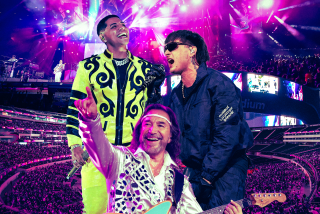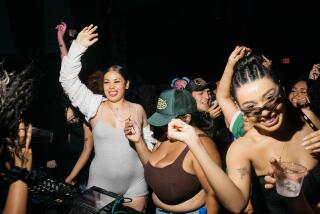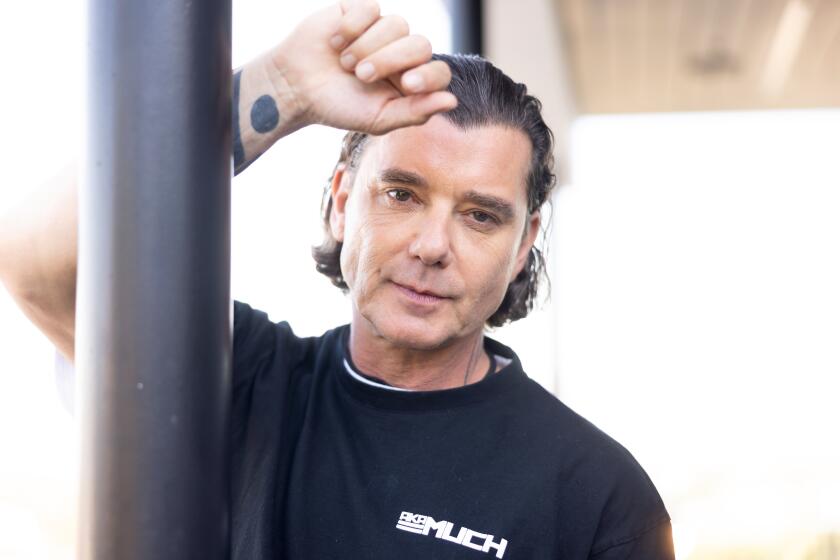Right Here, Right Now
- Share via
If only the original Fishbone were together these days, they could see what theyve reaped. The progenitor of genre-busting, culture-clashing music was formed in 1979 in South Central L.A.a brilliant all-black funk-ska-punk-rock outfit that often languished in the identity politics of marketing machines and ethnic inertia. White kids said they were authentic, black kids said they were sellouts. Columbia, their label at the time, had no idea how to market them. And low record sales ensued.
The singular sound of Fishbone was an exception during the 80s, and for years after, L.A. was a place where punk was punk and rap was rap. In a city as diverse as this, music had remained insular, resigned to live in geographic isolation. If you wanted to see real Latin music, youd have to drive to East L.A.
But those days are over. And Los Angeles is now at the center of an eclectic music renaissance. L.A. has the best music scene in America right now, says Chris Ziegler, cofounder of L.A.s most formidable music magazine, the L.A. Record. Scenes from across L.A. are coming together and cross-pollinating in ways Ive never seen.
Nowadays, if 60s-inspired Cambodian psychedelic surf rock in Los Angeles strikes you as especially esoteric, you havent been paying attention. Genres, styles and identities are colliding in ways we havent witnessed since bands like Fishbone. In the L.A. County megalopolis of 9.9 million people, you can see acid rock in East L.A. hip-hop venues, DIY punk bands backed by trendy Hollywood deejays and indie bands scouting out the Little Phnom Penh karaoke scene for talent.
Why? Surely the Internet has been a factor, exposing people to everything from inner-city Baltimore club beats to Uyghur muqam music from the Xinjiang plains. But simply hearing something isnt always enough to grasp or reinterpret it. Youve got to see it with your own eyes. And nowhere is that easier than here.
Music clubs like the legendary Smell downtownwhere theres no age minimumhave put an emphasis not on velvet ropes or booze revenue but on quality artists. Id like to see our model supplant the traditional rock club, says Jim Smith, founder of the Smell, which also allows no alcohol on the premises. He may get his wish. Following in the Smells footsteps, L.A.s annual F Yeah Fest has become the premier underground all-ages music festival in the country. Other clubs across the city are starting to embrace the DIY philosophy. And when a show is simply about the music, good things happenlike experimentation. Were getting a lot more diversity now in the sound of the bands that come through here, says Smith. Its hard to pigeonhole exactly what Im hearing.
It wasnt that long ago when Paul Simon was heckled at Howard University for being guilty of cultural imperialism on his album Graceland. Or in the 80s, when Los Lobos played a punk show at the Grand Olympic Auditorium and was actually spit on by the largely working-class Caucasian audience. But whats especially interesting about the music in Los Angeles these days is that, unlike in eras past, theres no presumptive linchpin of authenticity. In fact, we are now in a post-authentic age.
Of course, in a county that overwhelmingly voted for Barack Obama, its possible that change has come to more than just politics: Attitudes about identity have shifted, and L.A. bands are borrowing and sampling elements from all over the city, often in the same song. The bottom line is that music belongs to everyone once again. The result is what Mitchell Frank, the owner of club Spaceland, describes as indie roots mishmash. That is, if you can name it at all.
L.A.s music is as good as its ever been. It has the serious national and international attention to show for it. And despite the ailing economy, its only getting better. Here are our picks for the best reps of L.A.s emerging eclectic sound...
THE KNUX
When Hurricane Katrina wiped out the New Orleans home of rappers Rah Al Millio and Krispy Kream, they took off for L.A. Turned out to be the best thing that couldve happened to them. After spending time soaking up the music of DJ Steve Aoki and the Hollywood hipster scene, the brothersknown collectively as the Knuxcombined their southern flow with Zeppelin-esque guitars, European electro-club beats and anything else they could throw in.F--k the black-and-white s--t, says Al Millio. There are no labelsno genres anymore. Theres just music, and its either good or its bad. The result was their debut album, Remind Me in 3 Days..., released last October on Interscopean effort for which the sibs wrote, produced and played every instrument. The album caught national attention and drew favorable comparisons to OutKasts Stankonia. A second disc is in the works. What can we expect? I cant even describe the stuff were working on now, says Al Millio. Its way out there. Stand back.
DENGUE FEVER
Part Cambodian psychedelic surf rock, part Ethiopian jazz and a big part L.A. cool, Dengue Fevers sound is something youre unlikely to hear anywhere else. The band formed in 2002 after brothers Ethan and Zac Holtzman traveled to Cambodia and became captivated with the music. Everyone in the L.A. indie world was trying to sound like Radiohead, says Ethan Holtzman. We just wanted to do something different.They scoured the karaoke scene in Long Beachs Little Phnom Penh for the right singer. They found Chhom Nimol, a recent Cambodian émigré who, the band says, had sung regularly for the king and queen back home.It was the perfect fitDengue Fevers sound has drawn international acclaim. Singing mostly in Khmer, Nimol uses her voice like an instrument, resulting in a vibrato thats both spiritual wail and come-hither sexiness. The subject of the tour documentary Sleepwalking Through the Mekong, the band is set to play the KCRW World Festival in July at the Hollywood Bowl.
EDWARD SHARPE & THE MAGNETIC ZEROS
A little more than two years ago, Alex Ebert, frontman for the popular new wave-indie group Ima Robot, holed up in an L.A. apartment and tried to write his way through a bit of an existential crisis. As weeks passed, other musicians joined him, and what eventually emerged was the 11-member infectiously joyous gypsy-folk carnival known as Edward Sharpe & the Magnetic Zeros. I think we tried to create our own utopia, muses Ebert. The groups only constant is a state of childlike wonder, and its sound can fall anywhere from 60s psychedelia to dance rock to sea shanty. After blowing away crowds at this years South by Southwest fest, the bands first album, Up from Below, is due out in July on Eberts Community Records label. Nearly everyone had been involved in the 80s-inspired indie scene for quite some time, says Spacelands Frank. Suddenly theyre a polyrhythmic, polyphonic band with danceable undertones. Its amazing.
FOOL’S GOLD
Bass player Luke Top and guitarist Lewis Pesacov were longtime friends with a shared love for world music when they started fronting informal African-inspired dance sessions two years ago at clubs like Spaceland. The sound caught on, and soon musicians from across the city were clamoring to sit in with the ever expanding ensembles. I think people used to come to our shows just so they could jump onstage, jokes Top.With a current roster of 10 to 12 musicians on any given night, playing a distinctive hybrid of dance sounds from West Africa, Eritrea and Ethiopia, there just arent a lot of bands out there like Fools Gold, says Spacelands Frank. For good measure, Top sings in Hebrew. After a monthlong residency at the Echo recently, the bands first EP is due out this fall on I Am Sound Records. But theyre not done evolving. This is dance music. Were probably going to add some synth elements, says Pesacov, and keep on getting dancier.
VERY BE CAREFUL
Playing a variation of Colombian vallenato music with punk attitude, Very Be Careful has been blurring the line between indie and world music for more than a decade, paving the way for the citys current open-minded spirit. Weve been able to jump around from rock clubs to Latino venues, says bass player Arturo Guzman. Weve been doing it our whole career.The band formed in 1997 out of the Peace and Justice Center in Westlake, near downtown, an underground haven for Eastside musicians throughout the 90s that helped launch Ozomatli and the Black Eyed Peas Will.I.Am. It was like Lord of the Flies, says Guzman of the now defunct center. A bunch of crazy people from all over the city coming together and jamming.But Very Be Careful has kept the flavor of the place alive throughout L.A., playing wild, danceable music without getting sucked into any world-music-identity politics. Were happy making an impact and inspiring others to do the same, says Guzman, regardless of skin color.
More to Read
The biggest entertainment stories
Get our big stories about Hollywood, film, television, music, arts, culture and more right in your inbox as soon as they publish.
You may occasionally receive promotional content from the Los Angeles Times.











